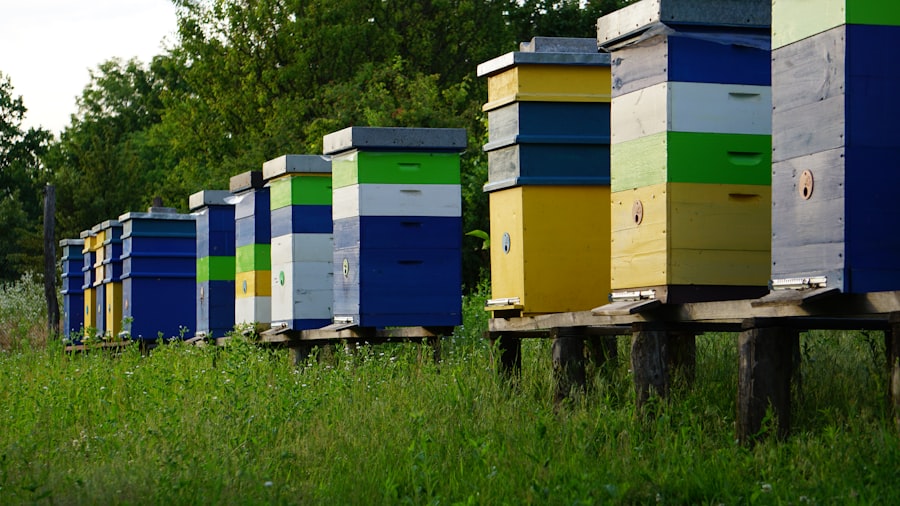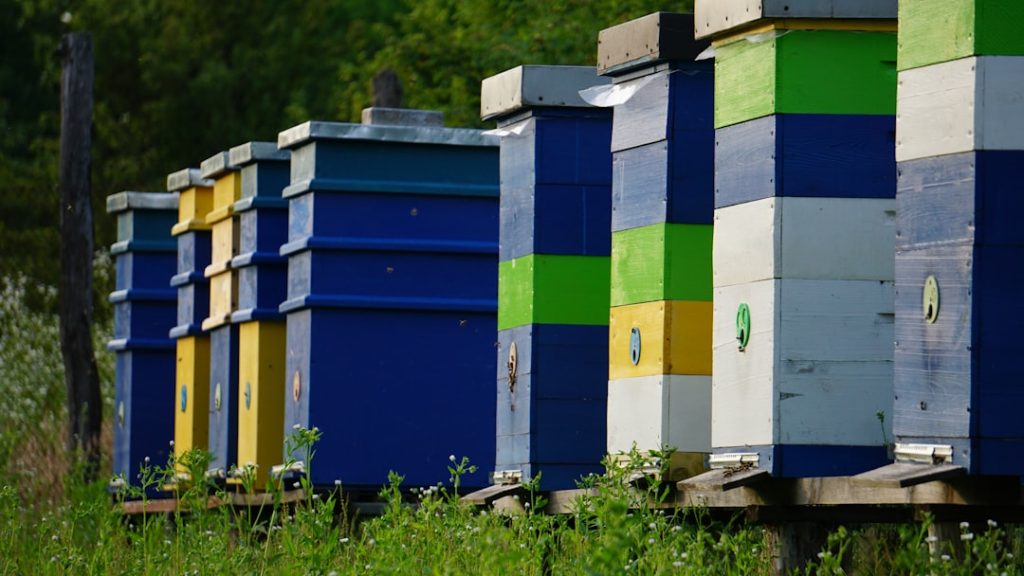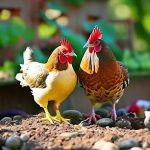Keeping bees and chickens together offers numerous advantages for both beekeepers and chicken owners. Bees and chickens have a symbiotic relationship, with each species benefiting from the other’s presence. Bees are crucial pollinators for plants, including those that chickens consume.
In turn, chickens benefit from increased pollination in their environment, resulting in a greater abundance of forageable plants, fruits, and vegetables. Bees also produce honey, which serves as a nutritious food source for both humans and chickens. Honey’s antibacterial properties can contribute to improved chicken health and well-being.
Maintaining both bees and chickens can promote a more sustainable and self-sufficient lifestyle. By producing honey and eggs on-site, individuals can reduce their dependence on store-bought products, potentially leading to cost savings and increased self-reliance. The presence of bees can enhance the overall health of gardens and surrounding ecosystems, resulting in higher yields of fruits and vegetables for both human and chicken consumption.
This combination creates a mutually beneficial ecosystem that supports the well-being of both species and contributes to a more sustainable agricultural practice.
Table of Contents
- 1 Creating a Harmonious Environment for Bees and Chickens
- 2 Providing the Right Space and Resources for Bees and Chickens
- 3 Managing Potential Challenges and Risks
- 4 Integrating Beekeeping and Chicken Keeping Practices
- 5 Maximizing the Benefits of Beekeeping and Chicken Keeping
- 6 The Rewards of Keeping Bees with Chickens
- 7 FAQs
- 7.1 What are the benefits of keeping bees with chickens?
- 7.2 Are there any potential drawbacks to keeping bees with chickens?
- 7.3 What precautions should be taken when keeping bees with chickens?
- 7.4 Can keeping bees with chickens benefit the environment?
- 7.5 What are some considerations for integrating bees and chickens on a property?
Key Takeaways
- Keeping bees with chickens can increase pollination and improve garden yields
- Bees and chickens can work together to control pests and improve soil health
- Providing a diverse and natural environment can benefit both bees and chickens
- Proper space and resources are essential for the well-being of bees and chickens
- Regular monitoring and proactive management can help mitigate potential challenges and risks
Creating a Harmonious Environment for Bees and Chickens
Meeting the Needs of Bees
To provide a harmonious environment for bees, it’s essential to offer them a diverse range of flowering plants that serve as a source of nectar and pollen. This can be achieved by planting a variety of flowers, herbs, and shrubs that bloom at different times throughout the year, ensuring a continuous supply of food for the bees.
Protecting Bees from Harmful Chemicals
It’s crucial to minimize the use of pesticides and other chemicals in the vicinity of the beehives, as these can be harmful to the bees and their ability to pollinate plants.
Creating a Comfortable Environment for Chickens
For chickens, a harmonious environment involves providing a safe and comfortable living space. This includes a secure coop for shelter at night, as well as access to a spacious outdoor area where they can roam and forage. It’s also important to ensure they have access to fresh water and a balanced diet to support their health and egg production. Additionally, providing enrichment activities such as dust baths, perches, and toys can help keep the chickens mentally and physically stimulated.
By creating a harmonious environment that meets the needs of both bees and chickens, you can promote a thriving ecosystem on your property.
Providing the Right Space and Resources for Bees and Chickens

Providing the right space and resources for bees and chickens is essential for their well-being and productivity. When it comes to bees, it’s important to set up beehives in a location that receives plenty of sunlight and is sheltered from strong winds. This can help regulate the temperature inside the hive and promote the activity of the bees.
Additionally, providing a water source nearby, such as a shallow dish filled with pebbles or floating cork pieces, can ensure that the bees have access to water for cooling the hive and diluting honey. For chickens, providing the right space involves ensuring that they have enough room to move around freely both inside the coop and in their outdoor area. The general rule of thumb is to provide at least 2-3 square feet of space per chicken inside the coop, and 8-10 square feet per chicken in the outdoor run.
This can help prevent overcrowding and reduce the likelihood of aggressive behavior among the flock. Additionally, providing nesting boxes filled with clean bedding material can encourage the hens to lay their eggs in a designated area, making egg collection easier for the chicken owner. By providing the right space and resources for bees and chickens, you can create an environment where they can thrive and fulfill their natural behaviors.
Managing Potential Challenges and Risks
While keeping bees with chickens can be rewarding, it’s important to be aware of potential challenges and risks that may arise. One potential challenge is the risk of bee stings to both humans and chickens. To mitigate this risk, it’s important to place beehives in an area that is not frequented by people or animals, such as behind a fence or hedge.
Additionally, providing a water source specifically for the bees can help prevent them from seeking out water in areas where they may come into contact with humans or animals. Another potential challenge is the risk of predation on the beehives by animals such as bears, raccoons, or skunks. To protect the beehives from predators, it’s important to install sturdy fencing around the hives or use electric fencing as a deterrent.
Additionally, placing the hives on stands or platforms can make it more difficult for ground-dwelling predators to access them. When it comes to chickens, potential risks include disease outbreaks and predation by predators such as foxes or hawks. Implementing biosecurity measures such as regular health checks for the chickens and securing their coop with predator-proof fencing can help mitigate these risks.
By being proactive in managing potential challenges and risks, you can create a safer environment for both bees and chickens.
Integrating Beekeeping and Chicken Keeping Practices
Integrating beekeeping and chicken keeping practices involves finding ways for these two activities to complement each other and contribute to a more efficient and productive system. One way to integrate these practices is by using the chickens to help manage pests in the garden or orchard. Chickens are natural foragers and can help control insect populations by eating pests such as beetles, caterpillars, and grubs.
By allowing the chickens access to areas where pests are present, you can reduce the need for chemical pesticides while providing the chickens with a natural food source. Another way to integrate beekeeping and chicken keeping practices is by using the bees to improve pollination in areas where the chickens forage for food. By strategically placing beehives near fruit trees or vegetable gardens that are frequented by the chickens, you can increase the pollination of these plants, leading to higher yields of fruits and vegetables for both human and chicken consumption.
Additionally, using the honey produced by the bees as a supplement for the chickens can provide them with a nutritious treat while reducing waste from honey extraction. By finding ways to integrate beekeeping and chicken keeping practices, you can create a more holistic and sustainable system on your property.
Maximizing the Benefits of Beekeeping and Chicken Keeping

Creating a Thriving Environment
One way to maximize the benefits is by planning the layout of your property to create zones where bees and chickens can thrive together. For example, planting bee-friendly flowers near areas where chickens roam can provide both species with valuable resources while enhancing the aesthetic appeal of your property.
Diversifying Your Practices
Another way to maximize the benefits is by diversifying your beekeeping and chicken keeping practices to include different breeds or species. For example, keeping multiple hives with different types of honeybees can increase genetic diversity and resilience within your bee population. Similarly, raising different breeds of chickens with varying characteristics such as egg production, foraging ability, or temperament can provide you with a more versatile flock that meets your specific needs.
Ongoing Education and Skill Development
Furthermore, maximizing the benefits involves actively engaging in ongoing education and skill development related to beekeeping and chicken keeping. This may include attending workshops or seminars, joining local beekeeping or poultry associations, or seeking mentorship from experienced beekeepers or chicken owners. By continuously learning and improving your practices, you can enhance the well-being of your bees and chickens while maximizing their contributions to your homestead.
The Rewards of Keeping Bees with Chickens
In conclusion, keeping bees with chickens offers numerous rewards for both homesteaders and their animals. By creating a harmonious environment that meets the specific needs of bees and chickens, you can promote a thriving ecosystem that supports pollination, food production, and overall well-being. While there are potential challenges and risks associated with keeping bees with chickens, proactive management strategies can help mitigate these concerns.
Integrating beekeeping and chicken keeping practices allows homesteaders to take advantage of their synergistic relationship while maximizing their individual contributions. By diversifying breeds or species and continuously improving skills through education and mentorship, homesteaders can create a more sustainable and self-sufficient system that benefits both humans and animals alike. Ultimately, keeping bees with chickens not only provides valuable resources such as honey and eggs but also contributes to a more resilient and diverse ecosystem on your property.
The rewards of keeping bees with chickens extend beyond tangible benefits to include a deeper connection with nature and a sense of stewardship for the environment. As such, this harmonious relationship between bees and chickens offers countless rewards for those who are willing to embrace its potential.
If you’re interested in keeping chickens and bees together, you may also want to consider building an A-frame chicken coop to house your feathered friends. This article from Poultry Wizard provides helpful tips and instructions for creating a functional and space-saving coop for your chickens. Check it out here.
FAQs
What are the benefits of keeping bees with chickens?
Keeping bees with chickens can have several benefits. The bees can help with pollination of plants, which can improve the overall health and productivity of the garden. Additionally, the chickens can help control pests in the garden, and their presence can deter predators that may threaten the beehives.
Are there any potential drawbacks to keeping bees with chickens?
While there are benefits to keeping bees with chickens, there are also potential drawbacks to consider. Chickens may disturb the beehives and consume the bees, which can be detrimental to the bee population. Additionally, bees may sting the chickens if they feel threatened, which can cause stress and potential harm to the chickens.
What precautions should be taken when keeping bees with chickens?
To minimize potential issues, it’s important to provide adequate space between the beehives and the chicken coop. This can help reduce the likelihood of disturbances and conflicts between the bees and chickens. Additionally, providing a water source for the bees and chickens can help prevent competition for resources.
Can keeping bees with chickens benefit the environment?
Yes, keeping bees with chickens can benefit the environment. Both bees and chickens play important roles in the ecosystem. Bees are crucial for pollination, which supports the growth of plants and crops, while chickens can help control pests and contribute to soil health through their scratching and pecking behavior.
What are some considerations for integrating bees and chickens on a property?
When integrating bees and chickens on a property, it’s important to consider the specific needs of both species. Providing suitable housing, access to food and water, and ensuring proper management of the beehives and chicken coop are essential. Additionally, monitoring the interactions between the bees and chickens can help identify any issues and make adjustments as needed.
Meet Walter, the feathered-friend fanatic of Florida! Nestled in the sunshine state, Walter struts through life with his feathered companions, clucking his way to happiness. With a coop that’s fancier than a five-star hotel, he’s the Don Juan of the chicken world. When he’s not teaching his hens to do the cha-cha, you’ll find him in a heated debate with his prized rooster, Sir Clucks-a-Lot. Walter’s poultry passion is no yolk; he’s the sunny-side-up guy you never knew you needed in your flock of friends!







